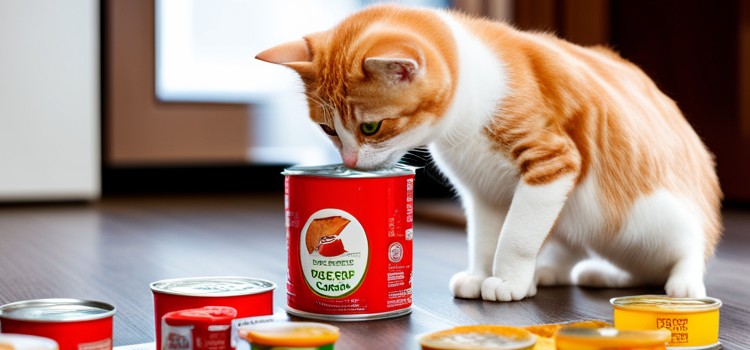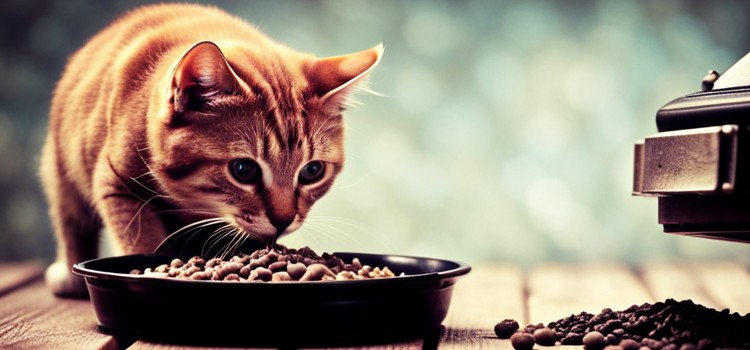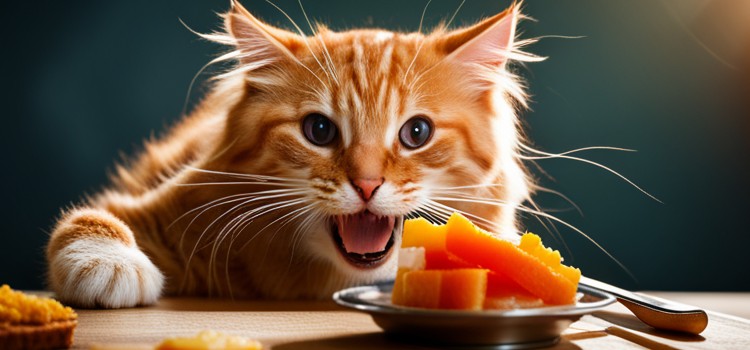As an Amazon Associate committed to the mission of improving the lives of our readers, Live-Clear.com receives a small commission from eligible purchases made through our affiliate links. This revenue enables us to keep producing insightful articles and other material.
Yes, cats can eat crab in moderation. Ensure the crab is fully cooked and free from seasonings.
Cats are obligate carnivores, thriving on meat-based diets. Crab meat can be a nutritious treat if given sparingly. It provides protein, vitamins, and minerals that can benefit your cat’s health. Always serve crab meat plain and cooked to avoid harmful bacteria or parasites.
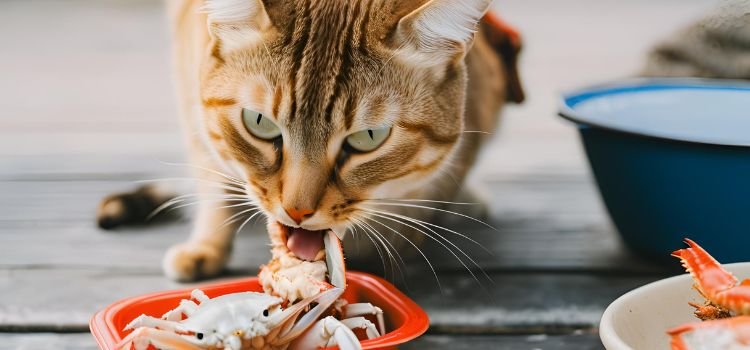
Avoid feeding your cat crab with seasonings, butter, or sauces, as these can upset their stomach. Introduce any new food gradually to monitor for allergies or digestive issues. Crab should complement a balanced diet, not replace it. Consult your vet before making dietary changes. Treats like crab should only make up a small portion of your cat’s overall diet.
Nutritional Value Of Crab
Crab is a popular seafood that many people enjoy. But can cats eat crab? While it is not a common part of a cat’s diet, understanding the nutritional value of crab can help determine if it is a suitable treat for your feline friend.
Protein Content
Crab is rich in protein, which is essential for a cat’s health. Protein helps build and repair tissues, making it crucial for growth and development. Here are some key points about the protein content in crab:
- High Protein: Crab meat contains around 20 grams of protein per 100 grams.
- Amino Acids: It provides all essential amino acids that cats need.
- Muscle Maintenance: Protein supports muscle maintenance and overall health.
The high protein content in crab can be beneficial for cats, especially those who are active or growing. But remember to serve it in moderation and ensure it is properly cooked to avoid any health risks.
Vitamins And Minerals
Crab is also a good source of vitamins and minerals that can benefit your cat. These nutrients play various roles in maintaining overall health:
| Vitamin/Mineral | Benefits |
|---|---|
| Vitamin B12 | Supports nerve function and red blood cell production. |
| Vitamin A | Essential for vision and immune function. |
| Iron | Important for oxygen transport in the blood. |
| Phosphorus | Supports healthy bones and teeth. |
| Zinc | Promotes skin health and wound healing. |
These vitamins and minerals help ensure your cat’s bodily functions are running smoothly. Including crab in their diet occasionally can provide these essential nutrients. Always make sure to remove any shells and cook the crab meat thoroughly to keep your cat safe.
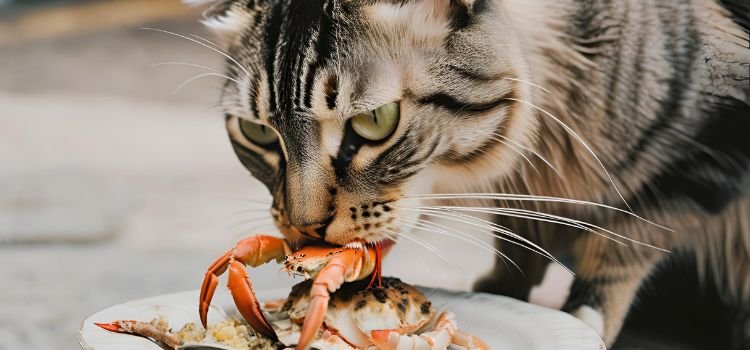
Potential Benefits For Cats
Many cat owners wonder if their furry friends can enjoy seafood treats like crab. Crab can be a delightful and nutritious addition to your cat’s diet, offering several potential benefits. Let’s explore how crab can contribute to your cat’s health and well-being.
Healthy Fats
Crab is rich in healthy fats that are essential for your cat’s overall health. These fats are crucial for maintaining a shiny coat, supporting brain function, and providing energy. Here are some key benefits of the healthy fats found in crab:
- Omega-3 Fatty Acids: These are anti-inflammatory and can help reduce the risk of chronic diseases.
- Omega-6 Fatty Acids: These promote skin health and can reduce dryness and itchiness.
Incorporating crab into your cat’s diet can help balance their intake of these essential fats. Here’s a table to illustrate the nutritional content of crab:
| Nutrient | Amount per 100g |
|---|---|
| Omega-3 Fatty Acids | 0.3g |
| Omega-6 Fatty Acids | 0.2g |
| Protein | 19g |
| Fat | 0.5g |
These nutrients are essential for your cat’s growth and development. Healthy fats also help in the absorption of fat-soluble vitamins like A, D, E, and K.
Supporting Joint Health
Crab contains several nutrients that can support your cat’s joint health. These nutrients are particularly beneficial for older cats or those with joint issues. Here are some of the key components:
- Glucosamine: This helps in the repair and maintenance of cartilage.
- Chondroitin: This helps to retain water in the cartilage, providing more cushion for the joints.
Including crab in your cat’s diet can help alleviate joint pain and improve mobility. Below is a brief overview of how these nutrients work:
| Nutrient | Function |
|---|---|
| Glucosamine | Rebuilds and repairs cartilage |
| Chondroitin | Retains water in cartilage |
| Calcium | Strengthens bones |
| Phosphorus | Works with calcium to build strong bones |
Feeding your cat crab can offer these joint-supporting nutrients, making it a great addition to their diet. Supporting joint health can lead to a more active and comfortable life for your cat.

Risks And Considerations
Crab is a popular seafood that many people enjoy. You might wonder if it’s safe for your cat to eat. While crab can be a tasty treat for your feline friend, there are several risks and considerations to keep in mind. Understanding these can help you make an informed decision.
Allergic Reactions
Not all cats can safely eat crab. Some cats might have allergic reactions to seafood. Allergies in cats can cause various symptoms, which might range from mild to severe. Here are some signs to watch for:
- Itching or scratching
- Swelling of the face or paws
- Vomiting or diarrhea
- Respiratory issues
If you notice any of these symptoms after your cat eats crab, contact your vet immediately. They can provide the best advice and treatment.
Also, keep in mind that the risk of allergies can be higher if your cat has never eaten seafood before. Start with a small amount and watch for any reactions. This cautious approach can help keep your cat safe.
Shell Hazards
Another important consideration is the risk of shell hazards. Crab shells can be dangerous for cats. They are hard and can cause injuries. Here are some potential problems:
- Choking hazard
- Damage to the mouth or throat
- Intestinal blockage
Always remove the shell before giving crab to your cat. Make sure the meat is in small, manageable pieces. This helps prevent choking and other injuries.
Additionally, crab shells can be sharp. They can cause cuts in your cat’s mouth or throat. This can lead to infections or other complications. Avoid giving your cat any part of the shell to ensure their safety.
Finally, cooked crab is safer than raw crab. Cooking helps kill harmful bacteria and parasites. This reduces the risk of foodborne illnesses for your cat.

Feeding Crab To Cats
Cats are known for their curious nature and love for exploring new foods. One such food is crab. But, can cats eat crab? Yes, they can. Feeding crab to cats can be a delightful treat if done correctly. Let’s dive into how you can prepare crab for your feline friend and the importance of moderation.
Preparation
Before serving crab to your cat, it’s important to prepare it properly. Raw crab can contain harmful bacteria and parasites. Always cook the crab meat before giving it to your cat. Boil or steam the crab without adding any spices, salt, or butter.
- Cook thoroughly: Ensure the crab meat is fully cooked. This kills any harmful pathogens.
- Remove shells: Crab shells are hard and can cause choking. Remove all shell pieces before serving.
- No seasoning: Seasonings can be toxic. Serve plain, unseasoned crab meat.
- Cut into small pieces: Cats have small mouths. Cut the crab meat into small, manageable pieces.
Here’s a quick table summarizing the preparation steps:
| Step | Action |
|---|---|
| 1 | Cook thoroughly |
| 2 | Remove shells |
| 3 | Avoid seasoning |
| 4 | Cut into small pieces |
Moderation
Feeding crab to your cat should always be done in moderation. While crab meat is a good source of protein, vitamins, and minerals, it should not replace your cat’s regular diet. Cats require a balanced diet to stay healthy. Too much crab can lead to nutritional imbalances.
Start by giving your cat a small amount of crab. Observe any signs of allergies or digestive issues. If everything seems fine, you can occasionally give crab as a treat.
- Small portions: Give small portions of crab meat. A teaspoon-sized amount is enough for a treat.
- Monitor health: Watch for any adverse reactions. Diarrhea or vomiting may indicate an issue.
- Frequency: Offer crab no more than once or twice a week.
Here’s a quick guideline on how to moderate crab feeding:
| Aspect | Guideline |
|---|---|
| Portion Size | Teaspoon-sized |
| Frequency | 1-2 times a week |
| Health Monitoring | Watch for allergies or digestive issues |
By following these guidelines, you can safely enjoy the occasional treat of crab with your cat.
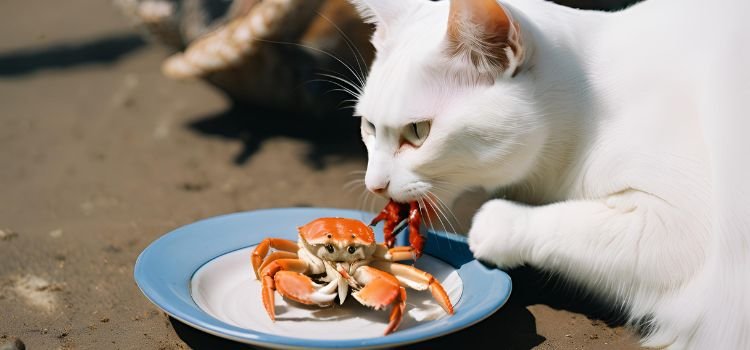
Alternatives To Crab
Cats are curious creatures with varied tastes. While they might show interest in eating crab, it is essential to consider their health and nutritional needs. Crab can be a tasty treat, but there are many other healthy alternatives to ensure a balanced diet for your feline friend. Let’s explore some safe protein sources and supplemental options for your cat.
Safe Protein Sources
Providing your cat with safe protein sources is crucial for their health. Here are some excellent alternatives to crab:
- Chicken: Boiled or grilled chicken is a great protein source. Ensure it’s unseasoned and boneless.
- Turkey: Like chicken, turkey is lean and nutritious. Serve it plain and cooked thoroughly.
- Fish: Cooked fish like salmon or tuna offers essential omega-3 fatty acids. Avoid raw fish due to parasites.
- Beef: Lean cuts of beef can be a tasty treat. Cook it well to kill any harmful bacteria.
- Eggs: Scrambled or boiled eggs are safe. They provide high-quality protein and vitamins.
Here’s a comparison table for quick reference:
| Protein Source | Benefits | Preparation Tips |
|---|---|---|
| Chicken | High in protein, low in fat | Boil or grill, no seasoning |
| Turkey | Lean protein, easy to digest | Cook thoroughly, no bones |
| Fish | Rich in omega-3 fatty acids | Cook well, avoid raw |
| Beef | High in iron and protein | Use lean cuts, cook properly |
| Eggs | Complete protein source | Scramble or boil |
Supplemental Options
In addition to primary protein sources, certain supplements can enhance your cat’s diet. These supplements provide essential nutrients:
- Omega-3 Fatty Acids: These support healthy skin and coat. Fish oil supplements are a good source.
- Taurine: This amino acid is vital for cats. It supports heart health and vision. Ensure it is present in their food.
- Vitamins: Vitamins A, D, and E are crucial. Multivitamin supplements can help if their diet lacks these.
- Probiotics: These improve digestion and gut health. Add a probiotic supplement to their food occasionally.
- Calcium: Important for bone health. Provide in the form of bone meal powder or specific supplements.
Using a mix of these supplemental options ensures your cat gets a balanced diet. Here’s a summary in a table format:
| Supplement | Benefits | Sources |
|---|---|---|
| Omega-3 Fatty Acids | Healthy skin and coat | Fish oil |
| Taurine | Heart health, vision | Meat, supplements |
| Vitamins | Overall health | Multivitamins |
| Probiotics | Improved digestion | Probiotic powder |
| Calcium | Strong bones | Bone meal powder |
By combining these safe protein sources and supplemental options, you can ensure your cat enjoys a nutritious and balanced diet.
Consulting A Veterinarian
Many pet owners wonder about their cats’ diet and whether certain foods are safe. One common question is, “Can cats eat crab?” Before introducing new foods, consulting a veterinarian is crucial. A vet can provide personalized advice, ensuring your cat’s health and well-being. This section will cover dietary recommendations and health monitoring when feeding your cat crab.
Dietary Recommendations
Before giving your cat crab, ask a veterinarian for advice. Vets understand your pet’s unique health needs and can offer specific guidance. Feeding your cat crab might seem harmless, but there are important points to consider:
- Moderation: Cats should eat crab in small amounts. Too much can upset their stomach.
- Preparation: Ensure the crab is cooked and free from any seasoning or additives. Raw crab can carry bacteria that might harm your cat.
- Remove Shells: Crab shells can be choking hazards. Always remove shells before serving.
Here’s a quick table to summarize the key points:
| Aspect | Recommendation |
|---|---|
| Amount | Small portions |
| Cooking | Fully cooked, no seasoning |
| Shells | Remove completely |
Following these recommendations can help prevent any adverse reactions. Always start with a tiny portion to see how your cat reacts.
Health Monitoring
After introducing crab to your cat’s diet, monitor their health closely. Keep an eye out for any unusual behaviors or symptoms. Here are some tips for health monitoring:
- Watch for Allergies: Some cats might be allergic to crab. Symptoms include itching, swelling, and difficulty breathing.
- Check Digestion: Notice any changes in your cat’s stool. Diarrhea or constipation might indicate digestive issues.
- Observe Energy Levels: A sudden drop in energy can be a sign something is wrong. Consult your vet if this happens.
Keep a journal to track any changes. Note the date you introduced crab and any symptoms observed. This can help your vet make informed decisions if any issues arise.
Crab can be a tasty treat for your cat, but always prioritize their health. Regular vet check-ups and careful monitoring ensure your furry friend stays happy and healthy.

Conclusion
Cats can enjoy crab in moderation as a treat. Ensure it’s cooked and free from harmful additives. Always consult your vet before introducing new foods. A balanced diet is key to your cat’s health. Treats like crab should not replace their regular, nutritionally complete meals.
Keep your feline friend healthy and happy.
Frequently Asked Questions
Yes, crab is safe for cats in moderation. Ensure it is cooked and free of seasonings. Avoid feeding raw crab to prevent health risks.
Cats should not eat raw fish, shellfish, or fish with high mercury levels like tuna. These can cause health issues.
Yes, pets can eat crab in moderation. Ensure it’s cooked and free from shells. Avoid seasoning and consult your vet first.
Yes, shellfish can be toxic to cats. It may cause vomiting, diarrhea, or allergic reactions. Always avoid feeding cats shellfish.
Yes, cats can eat crab meat in moderation. It should be fully cooked and free of seasoning.
Amazon and the Amazon logo are trademarks of Amazon.com, Inc, or its affiliates.

